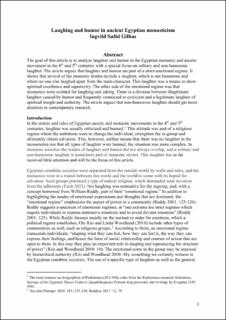| dc.contributor.author | Gilhus, Ingvild S. | |
| dc.date.accessioned | 2024-04-05T11:35:04Z | |
| dc.date.available | 2024-04-05T11:35:04Z | |
| dc.date.created | 2024-04-04T08:33:18Z | |
| dc.date.issued | 2024 | |
| dc.identifier.issn | 0933-1719 | |
| dc.identifier.uri | https://hdl.handle.net/11250/3125085 | |
| dc.description.abstract | The goal of this article is to analyze laughter and humor in the Egyptian monastic and ascetic movement in the 4th and 5th centuries with a special focus on solitary and non-humorous laughter. The article argues that laughter and humor were part of a strict emotional regime. It shows that several of the monastic stories include a laughter which is not humorous and where no one else laughed apart from the main character. This laughter was a means to show spiritual excellence and superiority. The other side of the emotional regime was that monastics were scolded for laughing and joking. There is a division between illegitimate laughter caused by humor and frequently connected to eroticism and a legitimate laughter of spiritual insight and authority. The article argues that non-humorous laughter should get more attention in contemporary research. | en_US |
| dc.language.iso | eng | en_US |
| dc.publisher | De Gruyter | en_US |
| dc.rights | Navngivelse 4.0 Internasjonal | * |
| dc.rights.uri | http://creativecommons.org/licenses/by/4.0/deed.no | * |
| dc.title | Laughing and humor in ancient Egyptian monasticism | en_US |
| dc.type | Journal article | en_US |
| dc.type | Peer reviewed | en_US |
| dc.description.version | acceptedVersion | en_US |
| cristin.ispublished | true | |
| cristin.fulltext | postprint | |
| cristin.fulltext | postprint | |
| cristin.qualitycode | 1 | |
| dc.identifier.doi | 10.1515/humor-2024-0002 | |
| dc.identifier.cristin | 2258727 | |
| dc.source.journal | Humor: An International Journal of Humor Research | en_US |
| dc.identifier.citation | Humor: An International Journal of Humor Research. 2024. | en_US |

